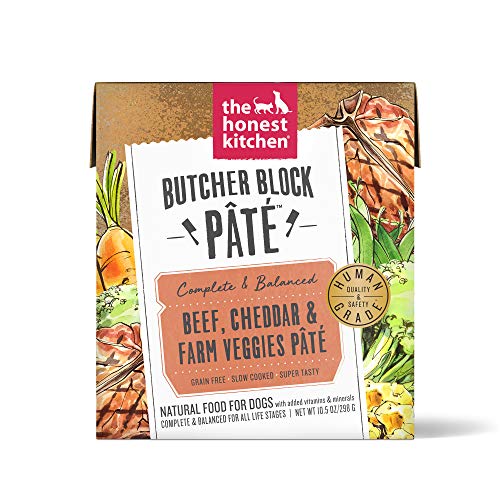
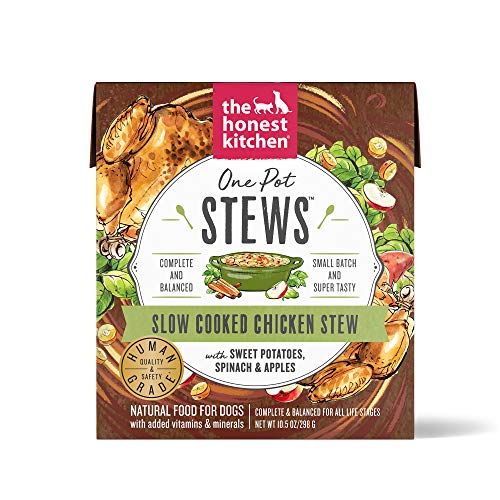
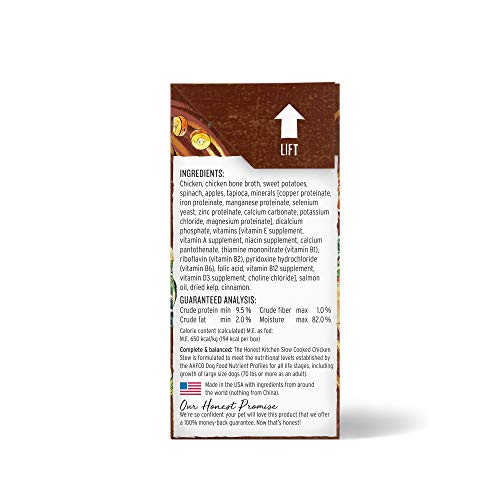
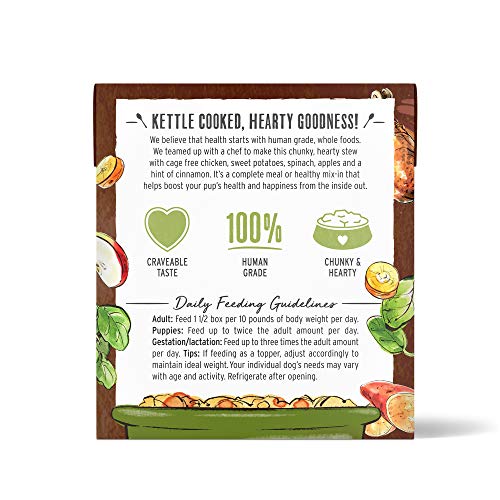
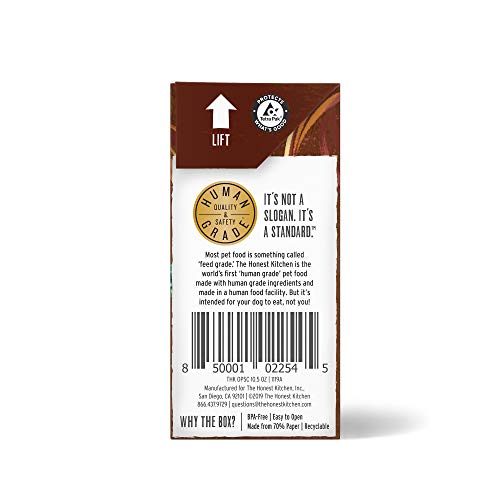
The Honest Kitchen Wet Dog Food - Human Grade, Complete & Balanced, No Fillers - 10oz


Cinnamomum Zeylanicum Bark Oil
High RiskCinnamomum zeylanicum bark oil is a volatile oil extracted from the bark of the Cinnamomum zeylanicum tree, commonly known as Ceylon cinnamon. It is primarily used for its aromatic properties and as a flavoring agent in various products.
Sustai Insights
Cinnamomum zeylanicum bark oil offers functional benefits as a flavoring agent and fragrance component. However, it is associated with high allergenic potential, which poses significant health risks, especially for sensitive individuals. Regulatory bodies have not issued current advisories, indicating low restrictions. Environmental risks, including pollutant potential, have not been documented. Given the high allergenic concern and associated risks, its overall risk level is assessed as high. Safe usage practices are advised, and alternatives like sweet orange oil may be considered.
Selenium
High RiskSelenium is a trace mineral essential for various bodily functions, including antioxidant activity and thyroid hormone metabolism. It is commonly found in dietary sources such as seafood, meat, and nuts. Selenium plays a role in immune function and may protect against oxidative stress.
Sustai Insights
Selenium offers functional benefits such as antioxidant properties and support for thyroid health. However, it poses health risks, including potential developmental and reproductive toxicity, though concerns about carcinogenicity and allergenic potential are low. Environmental risks include its persistence and bioaccumulation in ecosystems. Regulatory agencies have placed significant use restrictions on selenium, categorizing it as high risk overall. Safe usage practices are essential, and alternatives like zinc or vitamin E may be considered for similar benefits.
Vitamin D3
High RiskVitamin D3, also known as cholecalciferol, is a fat-soluble vitamin important for calcium metabolism and bone health. It is synthesized in the skin upon exposure to sunlight and is also found in some foods and supplements. Its primary function is to promote the absorption of calcium and phosphorus in the body.
Sustai Insights
Vitamin D3 offers functional benefits such as supporting bone health and immune function. However, excessive intake can lead to toxicity, presenting risks like hypercalcemia. Environmental concerns include its potential for bioaccumulation. Regulatory bodies impose usage restrictions due to these risks, resulting in a high overall risk assessment. Safe usage practices should be observed, and alternatives such as vitamin D2 may be considered.
Calcite
Low RiskCalcite is a mineral primarily made up of calcium carbonate (CaCO3). It is commonly found in sedimentary rocks and is used in various applications, including construction, agriculture, and as a filler in products due to its whiteness and brightness.
Sustai Insights
Calcite offers functional benefits such as acting as a filler and providing opacity in products. It is sustainably sourced and biodegradable. Health risks are minimal, with low concerns regarding carcinogenicity, allergies, and reproductive toxicity. Environmental risks are also low, as calcite does not contribute significantly to pollution or bioaccumulation. Regulatory bodies do not impose restrictions on its use, affirming its safety. Overall, the risk level associated with calcite is low, making it a safe ingredient in various applications.
Dicalcium Phosphate
Low RiskDicalcium phosphate is an inorganic salt commonly used as a dietary supplement and as a firming agent in various food products. It serves as a source of calcium and phosphorus, essential minerals for maintaining bone health and metabolic functions.
Sustai Insights
Dicalcium phosphate is recognized for its functional benefits, particularly as a calcium and phosphorus source that supports bone health. It poses low health risks, with minimal concerns regarding carcinogenicity, allergenic potential, and irritation. Environmentally, it does not significantly contribute to pollution or bioaccumulation. Regulatory bodies currently do not impose restrictions on its use, indicating a low overall risk assessment. Safe usage practices are recommended, and while alternatives exist, dicalcium phosphate remains a low-risk ingredient in various applications.
Potassium Chloride
Low RiskPotassium chloride is an inorganic salt commonly used as a potassium supplement and for its flavor-enhancing properties in food products. It serves as a mineral source and is utilized in various applications, including electrolyte balance in dietary formulations and as a partial substitute for sodium chloride.
Sustai Insights
Potassium chloride offers functional benefits as a potassium source, aiding in electrolyte balance and enhancing flavor. It is generally regarded as low risk, with minimal health concerns regarding carcinogenicity, allergies, or reproductive toxicity. Environmental impacts are also low, with no significant pollutant or bioaccumulation concerns noted. Regulatory bodies, including the FDA, do not impose restrictions on its use. Safe usage is advised to avoid excessive intake. Overall, potassium chloride is considered a safe ingredient with low risk, making it a viable option in various formulations.
Yeast
Low RiskYeast is a class of microorganisms from the Hemiascomycetes subphylum, widely used in food production and fermentation processes. It functions primarily as a leavening agent in baking and as a fermenting agent in brewing and winemaking. Yeast also plays a role in the production of certain dietary supplements.
Sustai Insights
Yeast serves as an effective leavening agent and contributes to fermentation, enhancing flavor and texture in foods. It is considered low risk regarding health concerns, with minimal associations with carcinogenicity, allergies, or reproductive toxicity. Environmentally, yeast is not a pollutant and does not bioaccumulate. Regulatory bodies, including the FDA, have no specific restrictions on its use. Given the low risk profile, yeast is a safe ingredient; however, individuals with specific allergies should consult health professionals. Alternatives like baking soda or sourdough starters may be considered for specific applications.
Cyanocobalamin (Vitamin B12)
Low RiskCyanocobalamin, commonly known as vitamin B12, is a water-soluble vitamin essential for red blood cell formation, neurological function, and DNA synthesis. It is utilized in dietary supplements and fortified foods to prevent or treat B12 deficiency, particularly in individuals with limited dietary intake or absorption issues.
Sustai Insights
Cyanocobalamin serves critical physiological functions including energy metabolism and red blood cell production. It is deemed safe with low health risk concerns across various categories such as cancer, allergies, and reproductive toxicity. Environmental impact is minimal, lacking bioaccumulation or significant pollutants. Regulatory bodies, including the FDA, recognize its safety, affirming low risk overall. Recommended usage involves adherence to established dietary allowances, with few noted alternatives. Therefore, the overall assessment indicates low risk.
Pyridoxine Hcl
Low RiskPyridoxine HCl is a substituted aromatic compound that serves as a form of vitamin B6. It is commonly used in dietary supplements and cosmetic formulations for its role in various metabolic functions and its contribution to skin health.
Sustai Insights
Pyridoxine HCl is known for its functional benefits in metabolic processes and skin health enhancement. It poses low health risks, including minimal concerns regarding carcinogenicity, allergies, and reproductive toxicity. Environmental risks are also low, as it is not classified as a pollutant or bioaccumulative substance. Regulatory agencies, including the FDA, have not imposed restrictions on its use. Overall, it is considered a low-risk ingredient, suitable for a variety of applications without significant health or environmental concerns.
Riboflavin
Low RiskRiboflavin, also known as Vitamin B2, is a water-soluble vitamin essential for energy production and cellular function. It plays a critical role in the metabolism of fats, carbohydrates, and proteins, and is commonly used as a dietary supplement and food additive for its color and nutritional benefits.
Sustai Insights
Riboflavin offers functional benefits, including its role in energy metabolism and as a food colorant. It is generally recognized as safe with low risk for allergies, carcinogenicity, and reproductive toxicity. However, excessive intake can lead to minor side effects such as yellow urine. Environmentally, riboflavin poses low pollutant potential and is not bioaccumulative. Regulatory bodies like the FDA have approved its use, establishing a low risk profile overall. Recommended usage levels are safe, and alternatives include other B vitamins, ensuring a balanced intake.
Tapioca
Low RiskTapioca is a starch extracted from the cassava root, primarily used as a thickening agent, binder, or texturizer in various food and cosmetic products. It is gluten-free and is often employed in gluten-free formulations, adding texture without altering flavor.
Sustai Insights
Tapioca serves functional benefits such as thickening and stabilizing products while being a gluten-free option. It is sustainably sourced and biodegradable. Health risks are minimal, with low concerns for carcinogenicity, allergies, and reproductive toxicity. Environmental risks are also low, with no significant pollution or bioaccumulation issues. Regulatory bodies do not impose restrictions on its use, leading to an overall low risk assessment. Safe usage practices are encouraged, and alternatives like arrowroot or cornstarch may be considered for similar functions.
Vitamin B3
Low RiskVitamin B3, also known as niacin or nicotinic acid, is an organic compound that plays a crucial role in various metabolic processes in the body. It is commonly used in cosmetic formulations for its ability to improve skin texture and enhance moisture retention, thereby contributing to overall skin health.
Sustai Insights
Vitamin B3 offers functional benefits such as improving skin hydration, reducing the appearance of fine lines, and enhancing overall skin tone. It is generally recognized as safe, with low associated health risks, including minimal concerns for carcinogenicity, allergies, or reproductive toxicity. Environmentally, it poses low risks and is not classified as a pollutant or bioaccumulative. Regulatory bodies have not placed substantial restrictions on its use, affirming its safety in cosmetic applications. Overall, Vitamin B3 is considered a low-risk ingredient, with no significant adverse effects reported. Safe usage practices include using within recommended concentrations, and alternatives like Vitamin B5 can be considered for similar benefits.
Pyridoxine
Low RiskPyridoxine is a substituted aromatic compound, primarily known as vitamin B6. It plays a crucial role in various metabolic processes, including amino acid metabolism, neurotransmitter synthesis, and the production of hemoglobin.
Sustai Insights
Pyridoxine serves essential functions in metabolic processes and is vital for overall health. It poses low health risks, with minimal concerns related to carcinogenicity, allergies, or reproductive toxicity. Environmentally, it is not considered a pollutant or bioaccumulative. Regulatory bodies have not imposed significant restrictions, indicating a low risk overall. Safe usage practices are encouraged, and alternatives like other B vitamins can be considered.
Spinacia Oleracea (Spinach)
Low RiskSpinacia oleracea (spinach) is a leafy green vegetable known for its nutrient density and is commonly used in various food products for its flavor and health benefits. It contains vitamins, minerals, and antioxidants, making it a popular ingredient in salads, smoothies, and dietary supplements.
Sustai Insights
Spinach offers functional benefits such as nutrient enrichment and antioxidant properties, contributing positively to health. It is sustainably sourced and biodegradable. Health risks are minimal, with low concerns regarding carcinogenicity, allergies, or reproductive toxicity. Environmental hazards are low, and it poses no regulatory warnings. Overall, it is assessed as a low-risk ingredient suitable for various uses.
Folic Acid
Low RiskFolic acid, also known as vitamin B9, is a water-soluble vitamin essential for DNA synthesis, repair, and methylation. It plays a critical role in cell division and is particularly important during periods of rapid growth, such as pregnancy and fetal development. It is commonly included in dietary supplements and fortified foods.
Sustai Insights
Folic acid offers functional benefits as a vital nutrient for cellular processes and is generally recognized as safe with low associated health risks, including carcinogenicity, allergenic potential, and reproductive toxicity. It is not restricted by regulatory bodies, and sustainable sourcing practices are often employed. Environmental risks are minimal, with no significant pollutant or bioaccumulation concerns. While the ingredient can be beneficial for pregnant women, safe usage practices should be observed to avoid excessive intake. Overall, the risk level associated with folic acid is low, with no major adverse effects reported.
Calcium Pantothenate
Low RiskCalcium pantothenate is a calcium salt of pantothenic acid (vitamin B5), commonly used as a dietary supplement and in cosmetic formulations. It serves as a conditioning agent, promoting skin hydration and improving product texture, thus enhancing the overall effectiveness of formulations.
Sustai Insights
Calcium pantothenate offers several functional benefits, including skin conditioning and hydration properties, contributing positively to product performance. It is generally considered safe, with low concerns regarding health risks such as carcinogenicity and allergies. Environmental risks are minimal, as it is neither bioaccumulative nor a significant pollutant. Regulatory bodies like the FDA have approved its use, with no substantial restrictions noted. Overall, it presents a low risk profile. For safer alternatives, options like sodium hyaluronate may be considered in formulations.
Calcite
Low RiskCalcite is a mineral primarily made up of calcium carbonate (CaCO3). It is commonly found in sedimentary rocks and is used in various applications, including construction, agriculture, and as a filler in products due to its whiteness and brightness.
Sustai Insights
Calcite offers functional benefits such as acting as a filler and providing opacity in products. It is sustainably sourced and biodegradable. Health risks are minimal, with low concerns regarding carcinogenicity, allergies, and reproductive toxicity. Environmental risks are also low, as calcite does not contribute significantly to pollution or bioaccumulation. Regulatory bodies do not impose restrictions on its use, affirming its safety. Overall, the risk level associated with calcite is low, making it a safe ingredient in various applications.
Dicalcium Phosphate
Low RiskDicalcium phosphate is an inorganic salt commonly used as a dietary supplement and as a firming agent in various food products. It serves as a source of calcium and phosphorus, essential minerals for maintaining bone health and metabolic functions.
Sustai Insights
Dicalcium phosphate is recognized for its functional benefits, particularly as a calcium and phosphorus source that supports bone health. It poses low health risks, with minimal concerns regarding carcinogenicity, allergenic potential, and irritation. Environmentally, it does not significantly contribute to pollution or bioaccumulation. Regulatory bodies currently do not impose restrictions on its use, indicating a low overall risk assessment. Safe usage practices are recommended, and while alternatives exist, dicalcium phosphate remains a low-risk ingredient in various applications.
Potassium Chloride
Low RiskPotassium chloride is an inorganic salt commonly used as a potassium supplement and for its flavor-enhancing properties in food products. It serves as a mineral source and is utilized in various applications, including electrolyte balance in dietary formulations and as a partial substitute for sodium chloride.
Sustai Insights
Potassium chloride offers functional benefits as a potassium source, aiding in electrolyte balance and enhancing flavor. It is generally regarded as low risk, with minimal health concerns regarding carcinogenicity, allergies, or reproductive toxicity. Environmental impacts are also low, with no significant pollutant or bioaccumulation concerns noted. Regulatory bodies, including the FDA, do not impose restrictions on its use. Safe usage is advised to avoid excessive intake. Overall, potassium chloride is considered a safe ingredient with low risk, making it a viable option in various formulations.
Yeast
Low RiskYeast is a class of microorganisms from the Hemiascomycetes subphylum, widely used in food production and fermentation processes. It functions primarily as a leavening agent in baking and as a fermenting agent in brewing and winemaking. Yeast also plays a role in the production of certain dietary supplements.
Sustai Insights
Yeast serves as an effective leavening agent and contributes to fermentation, enhancing flavor and texture in foods. It is considered low risk regarding health concerns, with minimal associations with carcinogenicity, allergies, or reproductive toxicity. Environmentally, yeast is not a pollutant and does not bioaccumulate. Regulatory bodies, including the FDA, have no specific restrictions on its use. Given the low risk profile, yeast is a safe ingredient; however, individuals with specific allergies should consult health professionals. Alternatives like baking soda or sourdough starters may be considered for specific applications.
Cyanocobalamin (Vitamin B12)
Low RiskCyanocobalamin, commonly known as vitamin B12, is a water-soluble vitamin essential for red blood cell formation, neurological function, and DNA synthesis. It is utilized in dietary supplements and fortified foods to prevent or treat B12 deficiency, particularly in individuals with limited dietary intake or absorption issues.
Sustai Insights
Cyanocobalamin serves critical physiological functions including energy metabolism and red blood cell production. It is deemed safe with low health risk concerns across various categories such as cancer, allergies, and reproductive toxicity. Environmental impact is minimal, lacking bioaccumulation or significant pollutants. Regulatory bodies, including the FDA, recognize its safety, affirming low risk overall. Recommended usage involves adherence to established dietary allowances, with few noted alternatives. Therefore, the overall assessment indicates low risk.
Cinnamomum Zeylanicum Bark Oil
High RiskCinnamomum zeylanicum bark oil is a volatile oil extracted from the bark of the Cinnamomum zeylanicum tree, commonly known as Ceylon cinnamon. It is primarily used for its aromatic properties and as a flavoring agent in various products.
Sustai Insights
Cinnamomum zeylanicum bark oil offers functional benefits as a flavoring agent and fragrance component. However, it is associated with high allergenic potential, which poses significant health risks, especially for sensitive individuals. Regulatory bodies have not issued current advisories, indicating low restrictions. Environmental risks, including pollutant potential, have not been documented. Given the high allergenic concern and associated risks, its overall risk level is assessed as high. Safe usage practices are advised, and alternatives like sweet orange oil may be considered.
Pyridoxine Hcl
Low RiskPyridoxine HCl is a substituted aromatic compound that serves as a form of vitamin B6. It is commonly used in dietary supplements and cosmetic formulations for its role in various metabolic functions and its contribution to skin health.
Sustai Insights
Pyridoxine HCl is known for its functional benefits in metabolic processes and skin health enhancement. It poses low health risks, including minimal concerns regarding carcinogenicity, allergies, and reproductive toxicity. Environmental risks are also low, as it is not classified as a pollutant or bioaccumulative substance. Regulatory agencies, including the FDA, have not imposed restrictions on its use. Overall, it is considered a low-risk ingredient, suitable for a variety of applications without significant health or environmental concerns.
Riboflavin
Low RiskRiboflavin, also known as Vitamin B2, is a water-soluble vitamin essential for energy production and cellular function. It plays a critical role in the metabolism of fats, carbohydrates, and proteins, and is commonly used as a dietary supplement and food additive for its color and nutritional benefits.
Sustai Insights
Riboflavin offers functional benefits, including its role in energy metabolism and as a food colorant. It is generally recognized as safe with low risk for allergies, carcinogenicity, and reproductive toxicity. However, excessive intake can lead to minor side effects such as yellow urine. Environmentally, riboflavin poses low pollutant potential and is not bioaccumulative. Regulatory bodies like the FDA have approved its use, establishing a low risk profile overall. Recommended usage levels are safe, and alternatives include other B vitamins, ensuring a balanced intake.
Tapioca
Low RiskTapioca is a starch extracted from the cassava root, primarily used as a thickening agent, binder, or texturizer in various food and cosmetic products. It is gluten-free and is often employed in gluten-free formulations, adding texture without altering flavor.
Sustai Insights
Tapioca serves functional benefits such as thickening and stabilizing products while being a gluten-free option. It is sustainably sourced and biodegradable. Health risks are minimal, with low concerns for carcinogenicity, allergies, and reproductive toxicity. Environmental risks are also low, with no significant pollution or bioaccumulation issues. Regulatory bodies do not impose restrictions on its use, leading to an overall low risk assessment. Safe usage practices are encouraged, and alternatives like arrowroot or cornstarch may be considered for similar functions.
Vitamin B3
Low RiskVitamin B3, also known as niacin or nicotinic acid, is an organic compound that plays a crucial role in various metabolic processes in the body. It is commonly used in cosmetic formulations for its ability to improve skin texture and enhance moisture retention, thereby contributing to overall skin health.
Sustai Insights
Vitamin B3 offers functional benefits such as improving skin hydration, reducing the appearance of fine lines, and enhancing overall skin tone. It is generally recognized as safe, with low associated health risks, including minimal concerns for carcinogenicity, allergies, or reproductive toxicity. Environmentally, it poses low risks and is not classified as a pollutant or bioaccumulative. Regulatory bodies have not placed substantial restrictions on its use, affirming its safety in cosmetic applications. Overall, Vitamin B3 is considered a low-risk ingredient, with no significant adverse effects reported. Safe usage practices include using within recommended concentrations, and alternatives like Vitamin B5 can be considered for similar benefits.
Pyridoxine
Low RiskPyridoxine is a substituted aromatic compound, primarily known as vitamin B6. It plays a crucial role in various metabolic processes, including amino acid metabolism, neurotransmitter synthesis, and the production of hemoglobin.
Sustai Insights
Pyridoxine serves essential functions in metabolic processes and is vital for overall health. It poses low health risks, with minimal concerns related to carcinogenicity, allergies, or reproductive toxicity. Environmentally, it is not considered a pollutant or bioaccumulative. Regulatory bodies have not imposed significant restrictions, indicating a low risk overall. Safe usage practices are encouraged, and alternatives like other B vitamins can be considered.
Selenium
High RiskSelenium is a trace mineral essential for various bodily functions, including antioxidant activity and thyroid hormone metabolism. It is commonly found in dietary sources such as seafood, meat, and nuts. Selenium plays a role in immune function and may protect against oxidative stress.
Sustai Insights
Selenium offers functional benefits such as antioxidant properties and support for thyroid health. However, it poses health risks, including potential developmental and reproductive toxicity, though concerns about carcinogenicity and allergenic potential are low. Environmental risks include its persistence and bioaccumulation in ecosystems. Regulatory agencies have placed significant use restrictions on selenium, categorizing it as high risk overall. Safe usage practices are essential, and alternatives like zinc or vitamin E may be considered for similar benefits.
Spinacia Oleracea (Spinach)
Low RiskSpinacia oleracea (spinach) is a leafy green vegetable known for its nutrient density and is commonly used in various food products for its flavor and health benefits. It contains vitamins, minerals, and antioxidants, making it a popular ingredient in salads, smoothies, and dietary supplements.
Sustai Insights
Spinach offers functional benefits such as nutrient enrichment and antioxidant properties, contributing positively to health. It is sustainably sourced and biodegradable. Health risks are minimal, with low concerns regarding carcinogenicity, allergies, or reproductive toxicity. Environmental hazards are low, and it poses no regulatory warnings. Overall, it is assessed as a low-risk ingredient suitable for various uses.
Vitamin D3
High RiskVitamin D3, also known as cholecalciferol, is a fat-soluble vitamin important for calcium metabolism and bone health. It is synthesized in the skin upon exposure to sunlight and is also found in some foods and supplements. Its primary function is to promote the absorption of calcium and phosphorus in the body.
Sustai Insights
Vitamin D3 offers functional benefits such as supporting bone health and immune function. However, excessive intake can lead to toxicity, presenting risks like hypercalcemia. Environmental concerns include its potential for bioaccumulation. Regulatory bodies impose usage restrictions due to these risks, resulting in a high overall risk assessment. Safe usage practices should be observed, and alternatives such as vitamin D2 may be considered.
Folic Acid
Low RiskFolic acid, also known as vitamin B9, is a water-soluble vitamin essential for DNA synthesis, repair, and methylation. It plays a critical role in cell division and is particularly important during periods of rapid growth, such as pregnancy and fetal development. It is commonly included in dietary supplements and fortified foods.
Sustai Insights
Folic acid offers functional benefits as a vital nutrient for cellular processes and is generally recognized as safe with low associated health risks, including carcinogenicity, allergenic potential, and reproductive toxicity. It is not restricted by regulatory bodies, and sustainable sourcing practices are often employed. Environmental risks are minimal, with no significant pollutant or bioaccumulation concerns. While the ingredient can be beneficial for pregnant women, safe usage practices should be observed to avoid excessive intake. Overall, the risk level associated with folic acid is low, with no major adverse effects reported.
Calcium Pantothenate
Low RiskCalcium pantothenate is a calcium salt of pantothenic acid (vitamin B5), commonly used as a dietary supplement and in cosmetic formulations. It serves as a conditioning agent, promoting skin hydration and improving product texture, thus enhancing the overall effectiveness of formulations.
Sustai Insights
Calcium pantothenate offers several functional benefits, including skin conditioning and hydration properties, contributing positively to product performance. It is generally considered safe, with low concerns regarding health risks such as carcinogenicity and allergies. Environmental risks are minimal, as it is neither bioaccumulative nor a significant pollutant. Regulatory bodies like the FDA have approved its use, with no substantial restrictions noted. Overall, it presents a low risk profile. For safer alternatives, options like sodium hyaluronate may be considered in formulations.
Discover The Honest Kitchen Human Grade Wet Dog Food, crafted with love in small batches for an irresistible, chunky texture your dog will adore. Made entirely from 100% human-grade ingredients, this wholesome stew offers a nourishing meal free from fillers, by-products, and artificial additives.
- Nutritious Meal or Topper: Complete and balanced, it can serve as a standalone meal or a healthy topping for dry kibble.
- Pure Ingredients: No meat meals, grains, or artificial preservatives—just simple, whole ingredients for optimal pet health.
- Made in the USA: All ingredients are processed domestically, ensuring quality and safety without any imports from China.
- Health-Conscious Choice: Packed with nutrient-rich elements like chicken, sweet potatoes, and spinach, promoting your dog’s overall well-being.
- Easy to Serve: Simply open, scoop, and serve, with options to mix with dry food or warm it for extra comfort.
Elevate your pet's dining experience with this nutritious, ethical choice that aligns with your values.
Subscribe & Save with Sustai
- Best Price Guarantee: Always enjoy the lowest prices on sustainable home essentials.
- No Surprises: We’ll notify you before shipping. No hidden fees, ever.
- You’re in Charge: Change, pause, or cancel your subscription anytime with ease.
- Eco-Friendly Deliveries: Our grouped shipments mean less packaging and lower emissions.
Join us on a sustainable journey. Special offers for a limited time! Prices and promotions may change.
Recommended Products
Discover The Honest Kitchen Human Grade Wet Dog Food, crafted with love in small batches for an irresistible, chunky texture your dog will adore. Made entirely from 100% human-grade ingredients, this wholesome stew offers a nourishing meal free from fillers, by-products, and artificial additives.
- Nutritious Meal or Topper: Complete and balanced, it can serve as a standalone meal or a healthy topping for dry kibble.
- Pure Ingredients: No meat meals, grains, or artificial preservatives—just simple, whole ingredients for optimal pet health.
- Made in the USA: All ingredients are processed domestically, ensuring quality and safety without any imports from China.
- Health-Conscious Choice: Packed with nutrient-rich elements like chicken, sweet potatoes, and spinach, promoting your dog’s overall well-being.
- Easy to Serve: Simply open, scoop, and serve, with options to mix with dry food or warm it for extra comfort.
Elevate your pet's dining experience with this nutritious, ethical choice that aligns with your values.

You can have at most 2 Sustainable Steals products in your cart
Customer Reviews
Customers’ View
Customers generally express satisfaction with The Honest Kitchen Human Grade Wet Dog Food, particularly appreciating its high-quality, human-grade ingredients. Many users highlight the importance of such ingredients for their pets' health, with one reviewer noting, 'Human grade foods are important to me for my pets.' The product's ability to serve as a nutritious meal or topper has been praised, with multiple customers mentioning their dogs enjoying it. Despite some mixed reviews regarding portion sizes and individual dog preferences, the overall sentiment leans towards approval, emphasizing the product's commitment to quality and well-being. Environmentally conscious consumers may value its simple, wholesome ingredients, aligning with health-focused feeding practices for their pets. Overall, this wet dog food is viewed as a beneficial addition to a pet's diet.
AI-generated from the text of customer reviewsThis product has no reviews yet.





